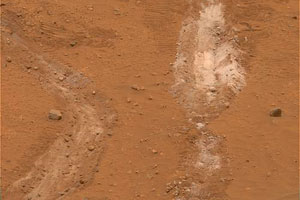 Gertrude Weise -- a deposit of silica uncovered by
Gertrude Weise -- a deposit of silica uncovered by
the wheel of NASA’s Mars Exploration Rover, Spirit.
Credit: NASA/Mars Exploration Rovers.
Watching the unfolding story of the exploration of our solar system's fourth planet is like watching an episode of CSI: Mars. Robotic orbiters, like police helicopters, constantly circle the neighborhood while determined rovers doggedly comb the ground for evidence. Back at the lab (Earth), forensics investigators put all the clues and data through detailed analyses, looking for the smoking gun that will solve the crime….
So what's the crime? In a headline, "Is Mars concealing a wetter, warmer past?"
As the Mars Exploration Rovers, Mars Reconnaissance Orbiter, and other spacecraft have revealed, signs of past liquid water flowing on Mars' surface are abundant -- though scientists still tend to couch the evidence with the caution that there are other processes in nature that can produce these signs. Still, the preponderance of evidence points so strongly to past liquid action on the Red Planet, sometimes you can almost taste the water.
What startling piece of evidence has our forensics team uncovered this week? In a headline, "Gertrude Weise: Scratching the Surface for Pay Dirt." I'll explain. NASA's Mars Exploration Rover Spirit, which has been exploring the giant Gusev Crater for about the past 1,200 Martian days, recently dragged its non-operational wheel through the dirt to reveal a deposit of white material, which it identified as silica (silicon dioxide -- same material that glass is made of). (One of Spirit's six wheels stopped working awhile back -- which has made it a good soil furrowing tool, or plough!)
